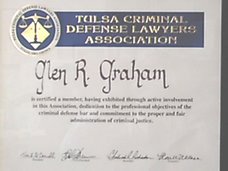http://www.okbar.org/members/sections/criminal/news14.pdf
Oklahoma's High Rate of Incarceration
Study Shows 1 of Every 12 Oklahoma Adults Have Been In Prison Or On Felony Probation
This study was done by the Oklahoma Criminal Justice Research Center in Sept., 2006. A description of the methodology for this study is on page 13. See the entire study on the OCJRC website at http://www.ocjrc.net
(Statistically in 2006 - Oklahoma led the nation in the rate of incarceration for women)
Oklahoma has a long history of a high incarceration rate, as documented by the annual publications of the U.S. Department of Justice, Bureau of Justice Statistics. At midyear 2005 (Harrison and Beck, 2006) there were more than 2.1 million persons in the custody of state and federal prisons, and local jails.
In Oklahoma nearly 1% of the entire adult population (those age 18 or over) was in prison at the end of August 2006. Between 1995 and 2005 nationally the number of prisoners in state prisons grew at a rate of 2.5% per year. The Oklahoma prison population grew faster, at a rate of 2.9% per year during this same ten year period. In addition to nationwide increases in the prison and jail populations, the incarceration rate per 100,000 resident population also increased.
Between 1995 and 2005 the national incarceration rate for all state prisoners increased by 14%, from 379 per 100,000 to 433 per 100,000 at midyear 2005. Oklahoma outpaced the national statistics, increasing 22% from 536 prisoners per 100,000 in 1995 to 655 per 100,000 in 2005. For the last twenty years Oklahoma has been a high incarceration state, ranking among the top four every year since 1986 (Bureau of Justice Statistics, 2006; Oklahoma Department of Corrections, 2002, p 24).
Incarceration rates document the extent of imprisonment (those in prison) at fixed points in time, compared to the total state population. What effect has the high incarceration rate over a long period of time had on the total population of Oklahoma?
Discussion
As expected, the prevalence of imprisonment in Oklahoma is much greater than for the U.S., approximately 60% greater. The rate for females in Oklahoma is nearly two and one-half times as great as the U.S. Among the racial and ethnic groups, similar to the national trend, the prevalence for Blacks is much greater than for Whites or Hispanics, but in Oklahoma the disparity is somewhat less pronounced. Oklahoma has ranked first in the imprisonment of female offenders (Bureau of Justice Statistics, 2006).
The current incarceration rate per adult population is 45% higher in Oklahoma than for the U.S.
The rate of first admissions to prison in Oklahoma is 47% higher in Oklahoma than for the U.S.
References:
Bonczar, T. (2003). Prevalence of imprisonment in the U.S. population, 1974- 2001. Washington, DC: U.S. Department of Justice, Bureau of Justice Statistics. Retrieved September 19, 2006 from the World Wide Web: http://www.ojp.usdoj.gov/bjs/pub/pdf/piusp01.pdf
Bonczar, T. & Beck, A. (1997). Lifetime likelihood of going to state or federal prison. Washington, DC: U.S. Department of Justice, Bureau of Justice Statistics. Retrieved September 19, 2006 from the World Wide Web: http://www.ojp.usdoj.gov/bjs/pub/pdf/llgsfp.pdf
Ewald, A. (2005). A “crazy-quilt” of tiny pieces: State and local administration of American criminal disenfranchisement law. Washington, DC: The Sentencing Project. Retrieved from the World Wide Web: http://www.sentencingproject.org/pdfs/crazyquilt.pdf
Harrison, P. & Beck, A. (2006). Prison and jail inmates at midyear 2005. Washington, DC: U.S. Department of Justice, Bureau of Justice Statistics. Retrieved September 20, 2006 from the World Wide Web: http://www.ojp.usdoj.gov/bjs/pub/pdf/pjim05.pdf
Love, M. (2005). Relief from the collateral consequences of a criminal conviction.
Washington, DC: The Sentencing Project. Retrieved September 19, 2006 from
the World Wide Web: http://www.sentencingproject.org/pdfs/rights-restoration/Oklahoma.pdf
Mauer, M. (2003). Invisible punishment: Block housing, education, voting. Washington, DC: Joint Center for Political and Economic Studies. Retrieved September 19, 2006 from the World Wide Web: http://www.sentencingproject.org/pdfs/mauerfocus.Pdf
Oklahoma Department of Corrections. (2002). Oklahoma Department of Corrections history: the 20th century. Oklahoma City, OK: Author. Retrieved September 20, 2006 from the World Wide Web: http://www.doc.state.ok.us/docs/DOC%History.pdf
Oklahoma State Department of Health. (2006). Web-based vital statistics: Health care information. Oklahoma City, OK: Author. Retrieved September 19, 2006 from the World Wide Web: http://www.health.state.ok.us/stats/vs/deathformicd10.html
The Sentencing Project. (2006). Felony disenfranchisement laws in the United States. Washington, DC: Author. Retrieved September 19, 2006 from the World Wide Web: http://www.sentencingproject.org/pdfs/1046.pdf
U.S. Census Bureau. (2005). SC-EST2004-Alldata6: State population estimates by demographic characteristics with 6 race groups (5 race alone groups and one group with two or more race groups): April 1, 2000 to July 1, 2004. Washington, DC: Author.
Retrieved July 24, 2006 from the World Wide Web: http://www.cenus.gov/popest/datasets.html
U.S. Department of Justice, Bureau of Justice Statistics. (2006). Prisoners in 1994 through Prisoners in 2004. Washington, DC: Author. Retrieved September 20, 2006 from the World Wide Web: http://www.ojp.usdoj.gov/bjs/prisons.htm#publications
Oklahoma's High Rate of Incarceration
Subscribe to:
Post Comments (Atom)






4 comments:
My opinion is that a criminal can not get a break in Oklahoma because all of the fines they get along with their prison time. I think they should have a clean record after they do their time. It is hard enough for them to get a job. Then they have to take all kinds of courses to get drivers license wich the state of Oklahoma benifits on. When they can't get a job they get thrown back in jail. What is the statistics for multiple prison times.
We need to start realizing the prisons are no longer used but for revenge and hatred. Folks commit crimes in many cases due to drug/alcohol abuse or theft due to no work and tossing them in prisons does not give them any help to overcome what leads possibly to the crime. We need to be putting money into educational porograms, treatment centers, rehabiliation programs etc. But the prison system and fema camps are big business and continues to grow at a alarming rate. Please read my sons story www.rickyslife.com or google "teens branded as sex offenders" and tell me how many kids are in OK prisons very similar? How many falsely accused? If they learn a life of being treated so horribly what skills do they ahve upon relase? AS the othe rcommentor said if they serve thier time they should suffer no record or registration (like my son's case) and be free to be a productive citizne who pays taxes. Its time we demand change as we the people vote these corrupt politicians in we can come togethr and educate citizens and vote their sorry backsides out!! www.cfcoklahoma.org or www.cfciowa.org Thanks and a free educational brochure write me at rickysmom@rickyslife.com
Nice post, Glenn. And nice blog. Keep up the good work. I will be linking this to a post on a blog, madmikesamerica.com tomorrow.
I totally agree with the first comment. Multiple prison is meaning less.
Post a Comment